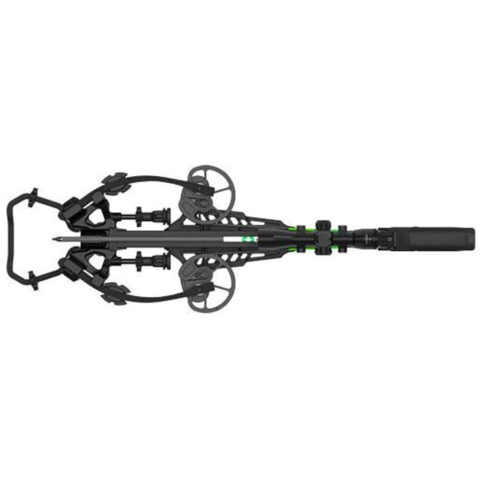The AR-15 is widely recognized as one of the most popular rifles in the United States, cherished by hunters, competitive shooters, and individuals focused on home defense. Its appeal is largely due to its adaptability and the extensive range of customization options available, making it a top pick among firearm enthusiasts.
In this exploration, we’re going to dive into the effective range of an AR-15, which can vary significantly based on several factors. For a standard AR-15 equipped with a 16-inch barrel, the effective range typically extends up to 500 to 600 meters, depending on the ammunition used and environmental conditions. This range is considered optimal for achieving a balance between velocity and accuracy.
However, “It depends” truly encapsulates the core of our discussion, as various elements can influence how far and accurately this rifle can shoot. Our objective is to unpack these factors and provide a comprehensive understanding of what contributes to the AR-15’s range capabilities, enhancing both performance and shooting experience. Let’s dive into the specifics and discover what changes or upgrades can affect the shooting distance of this iconic rifle.
Understanding Barrel Length and Its Impact on Range
Barrel length in an AR-15 significantly influences the rifle’s velocity and accuracy. The longer the barrel, the more time the propellant has to burn completely before the bullet exits the muzzle. This complete burn increases the bullet’s velocity, which in turn can enhance both range and accuracy.

Here’s a breakdown of how different barrel lengths affect the AR-15’s performance:
- 14.5-inch barrel: Typically generates a muzzle velocity around 2,900 feet per second with standard M855 5.56 NATO rounds. The shorter barrel length makes it more maneuverable, ideal for close quarters but limits its effective range to about 450 meters. The velocity drop-off at longer distances affects both accuracy and impact power.
- 16-inch barrel: Considered the standard for civilian use, this length strikes a balance between maneuverability and ballistic performance. It can push the same M855 rounds to about 3,000 feet per second, effectively extending the accurate engagement distance up to 500-600 meters. This length is a versatile option, providing sufficient velocity for a flat trajectory over medium distances.
- 18-inch barrel: This length increases muzzle velocity to approximately 3,100 feet per second, enhancing long-range performance due to a flatter trajectory and reduced wind drift. The 18-inch barrel is favored for its increased accuracy and effectiveness up to 650 meters, making it a popular choice for competitive shooting and hunting.
- 20-inch barrel: The longest common length for an AR-15, the 20-inch barrel can achieve velocities up to 3,200 feet per second. This length maximizes the ballistic potential of the rifle, extending its effective range well beyond 700 meters. The increased barrel length helps maintain a very flat trajectory over longer distances, making it ideal for precision shooting where accuracy at extended ranges is crucial.
Each barrel length offers unique advantages depending on the intended use and shooting conditions. Expert shooters often select their barrel length based on the specific balance of speed, maneuverability, and range they aim to achieve.
The Role of Barrel Twist Rate
Barrel twist rate is crucial in determining how a bullet stabilizes and performs once fired from an AR-15. Essentially, twist rate refers to the rate at which the rifling inside the barrel spirals, with the measurement indicating how many inches of barrel are needed for the rifling to make one complete revolution. For instance, a 1:7 twist rate means the bullet rotates one full turn every seven inches of barrel.
The twist rate is vital for stabilizing different weights and types of bullets:
- 1:7 twist rate: This is a faster twist rate that is excellent for stabilizing heavier and longer bullets, such as those weighing more than 62 grains. It is particularly effective with bullets up to 77 grains or more, which are often used for longer-range shooting, potentially effective up to 800 meters or more under ideal conditions. The faster spin ensures the bullet remains stable over longer distances, enhancing accuracy.
- 1:8 twist rate: Offering a balance between the capabilities of the 1:7 and 1:9 twist rates, the 1:8 is versatile enough to handle a broad range of bullet weights effectively, from about 55 to 75 grains. This twist rate is well-suited for shooters who wish to use a variety of ammunition types without specializing excessively in either lighter or heavier rounds, making it ideal for accurate shooting up to 600-700 meters.
- 1:9 twist rate: Ideal for lighter bullets, typically those weighing between 45 and 62 grains. This slower twist rate is excellent for short to medium-range engagements, where extremely heavy bullets are not necessary. It provides adequate stabilization for common bullet weights without overstabilizing them, which can be as detrimental as under-stabilization, typically ensuring effective performance up to 300-500 meters.
Understanding and selecting the appropriate twist rate according to the bullet weight and shooting application significantly affects an AR-15’s performance, making it a critical consideration for any shooter looking to optimize their rifle’s accuracy and effectiveness across varying ranges.

Ammunition Types and Their Influence on Shooting Distance
Choosing the right ammunition is critical to optimizing the performance of an AR-15, especially in terms of range and accuracy. The two primary types of ammunition used are 5.56 NATO and .223 Remington, each designed for specific purposes and with distinct characteristics.
5.56 NATO rounds are military-spec ammunition that typically exhibit higher pressures, resulting in higher muzzle velocities and flatter trajectories. These rounds are available in various bullet weights, commonly ranging from 55 to 77 grains. The heavier rounds are especially beneficial for long-range shooting due to their enhanced stability and resistance to wind drift.
.223 Remington rounds are similar in size to 5.56 NATO but are loaded to lower pressures for civilian use, affecting their velocity and effective range. They are popular for hunting and recreational shooting, with bullet weights that also range from 55 to 77 grains.
Impact of Bullet Weight and Design on Performance
- Lighter bullets (55 grains): These are typically faster and offer a flatter trajectory at short to medium ranges (up to 300 meters). Ideal for general target shooting and small game hunting, they perform best in barrels with a 1:9 twist rate, which provides adequate stability without over-spinning the bullet.
- Medium-weight bullets (62 to 69 grains): These bullets strike a balance between velocity and ballistic performance, making them suitable for varied shooting disciplines. They are commonly used in barrels with a 1:8 twist rate, which optimally stabilizes them for effective ranges up to 500 meters.
- Heavier bullets (77 grains and above): Designed for long-range accuracy, these bullets require a faster twist rate, such as 1:7, to maintain stability over longer distances. They excel in competitive shooting and tactical applications where precision is critical, effective up to 800 meters or more depending on environmental conditions.
Enhancing Accuracy with Free Floating Handguards
Free-floating handguards are a significant upgrade for AR-15 enthusiasts looking to enhance their rifle’s accuracy, particularly at longer ranges. Unlike traditional handguards that attach to the front of the barrel, free floating handguards only connect to the receiver. This design eliminates any contact with the barrel, preventing the handguard from exerting pressure on it during firing. The result is a more consistent barrel vibration and harmonics, which leads to improved accuracy. Additionally, free floating handguards allow for better heat dissipation and provide a stable platform for mounting accessories like bipods and lasers without affecting the barrel’s performance. This upgrade is particularly valuable for shooters who demand precision and consistency in their shooting, whether in competitive environments or hunting.

Specialized Ammunition Types
- Match-grade rounds: These are precision-engineered for consistency and accuracy. Match-grade ammunition is often heavier, with tighter specifications on bullet weight and shape to ensure minimal deviation in trajectory. For instance, 77-grain match-grade rounds are preferred in competitive settings, where they can significantly extend the range and accuracy of a well-tuned AR-15.
- Polymer-tipped and boat-tail bullets: These designs enhance the ballistic coefficient, meaning they maintain velocity and trajectory better over distance. Polymer-tipped rounds expand on impact, increasing efficacy in hunting applications, while boat-tail bullets reduce air resistance, making them ideal for long-range target shooting.
Interplay with Barrel Twist Rate: The relationship between bullet weight and barrel twist rate is fundamental in achieving desired shooting outcomes. For example, a 1:7 twist rate is too aggressive for light 55-grain bullets, potentially causing them to destabilize and lose accuracy. Conversely, using a 1:9 twist rate for heavy 77-grain bullets might not provide sufficient rotational stability, leading to reduced accuracy at longer ranges. Selecting the right combination ensures maximum effectiveness for specific shooting goals, whether for precision long-range engagements or rapid, close-quarters scenarios.
Understanding these dynamics allows shooters to tailor their ammunition choices to their specific needs and the capabilities of their rifle, enhancing both performance and shooting experience.
External Ballistic Factors
The performance of an AR-15 is not only determined by the rifle and its ammunition but also significantly influenced by external environmental conditions. Factors such as wind, humidity, and temperature can markedly affect the range and accuracy of shots.
Impact of Environmental Conditions
- Wind: The most significant external factor, wind can alter the bullet’s path, especially at longer ranges. Crosswinds can push the bullet sideways, necessitating windage adjustments on the rifle’s sights or scope. For instance, a strong side wind might require the shooter to aim several inches or feet to the side of the target, depending on the distance and wind speed.
- Humidity: Higher humidity can increase air density, which in turn can slow the bullet down slightly and affect its trajectory. While the effect is less pronounced than wind, it can still be critical at longer ranges. Shooters might need to adjust their elevation settings slightly to compensate.
- Temperature: Changes in temperature can affect the air density and the internal ballistics of how gunpowder burns. Cold weather can reduce muzzle velocity, leading to a lower trajectory, while hot weather can do the opposite. Adjustments in sight elevation might be necessary to accommodate these changes.

The Role of Optics in Extending Shooting Capability
Optics do not inherently increase the range of an AR-15 but they significantly enhance a shooter’s ability to engage targets at longer distances effectively. By providing a clearer and more magnified view of the target, optics help shooters achieve better aim and precision. This improved sighting from the optic assists in making accurate shots that might otherwise be beyond the shooter’s capability with iron sights alone, effectively extending the practical shooting range of the rifle.
Practical Adjustments for Different Weather Conditions
- In high winds, shooters should use wind flags or natural indicators like leaves and grass to gauge wind direction and speed. Learning to read these signs and practicing under various wind conditions can greatly improve accuracy.
- For varying humidity and temperature levels, understanding the specific impacts on your ammunition’s performance is key. This might mean choosing a different powder for reloading in extreme climates or adjusting sights as needed based on known effects.
- Overall, constant practice under varying conditions is invaluable. Many competitive shooters record the conditions and their adjustments in a shooter’s logbook, allowing them to reference past experiences for more informed shooting in future scenarios.
The Shooter’s Role in Maximizing Range
When it comes to shooting accurately at long distances, it’s not all about the AR-15 itself; a lot of the magic happens in the hands of the shooter. Let’s dive into what it takes to maximize your rifle’s range effectively.
Essential Techniques for Better Accuracy: Good shooting starts with the basics—posture, grip, and sighting. While it might seem straightforward, perfecting these can make all the difference. A stable stance, whether standing or prone, provides a solid foundation. Think of it as setting up a tripod for a camera; the steadier it is, the clearer the shot.
Precision in Practice: Refining your sighting technique, focusing keenly on aligning the sight perfectly each time, also plays a critical role. Just as a golfer visualizes their swing, a shooter must visualize the path of the bullet, accounting for every breath and the gentle squeeze of the trigger to avoid jerking the gun. Regular practice in different conditions teaches you the nuances of your rifle and how it reacts to your actions.
Advice from the Range: Seasoned shooters often share that the key to long-range accuracy isn’t just about handling the rifle but understanding and connecting with it. Each shot teaches something new about how slight changes in posture or breathing can influence the bullet’s trajectory.
Build Your Rifle For You: While a buying or building an AR-15 based on someone else’s recommendation or your favorite firearms influencer can be a great place to start, you need to build your AR-15 to your standards and needs.

Technological Enhancements and Accessories
Upgrading an AR-15 with the right technological enhancements and accessories can transform its capabilities, extending its range and improving its accuracy.
Choosing the Right Optics: Optical sights and scopes are game-changers. A scope with the right magnification for the intended distance can provide a clear view of the target, making it easier to achieve precise shots. For instance, a variable magnification scope allows for adjustments based on the target’s distance, providing versatility across different shooting scenarios.
The Impact of Attachments: Beyond optics, other attachments like bipods can provide the stability necessary for long-range shooting, mimicking the steadiness of a benchrest. Lightweight, adjustable bipods allow for quick setup and can significantly enhance performance by reducing rifle movement at the moment of firing.
Integrating Technology: Modern advancements such as ballistic calculators integrated into scopes or apps can provide real-time data, helping adjust shots for windage, elevation, and more. These tools can make a notable difference in long-range shooting by providing precise adjustments tailored to current conditions.
Together, these enhancements not only boost the rifle’s performance but also complement the shooter’s skill, creating a symbiotic relationship between human precision and mechanical accuracy.
Legal and Ethical Considerations in AR-15 Modifications and Usage
When it comes to modifying and using an AR-15, there are important legal and ethical considerations every owner must be aware of. Legally, federal regulations set the baseline, dictating which modifications are permissible, such as restrictions against converting firearms into fully automatic weapons. State laws can vary significantly, with some imposing strict limits on magazine capacities or specific features like barrel lengths and stock types. Therefore, before making any modifications to an AR-15, it’s crucial to consult local laws to ensure compliance.
Ethically, the use of an AR-15, especially for long-range shooting, demands a high level of responsibility. Long-range firearms, by their nature, have the potential to be hazardous if used carelessly. Ethical use means ensuring that shooting is conducted in a safe, controlled environment like a designated range and that the shooter maintains a clear understanding of their surroundings, particularly what lies beyond their target. It also means respecting the power of the weapon and the potential consequences of its use. Responsible shooters always prioritize safety, ensuring that their practices do not endanger others and that they are mindful of the implications of using such a powerful tool.
HME GHGLL Gambrel Game Hanger with Leg Lock 500 lbs
HME GHGLL Gambrel Game Hanger with Leg Lock 500 lbs Capacity



